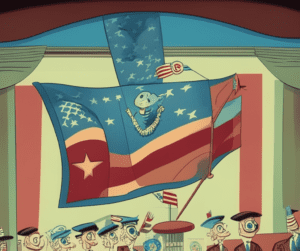On Wednesday, the Federal Reserve made an important decision by pausing its aggressive campaign of raising interest rates. This marks the first time in 18 months that the Fed has chosen not to increase rates. However, it is important to note that the central bank conveyed a clear message that its battle against inflation is far from over.
Based on the average estimates of officials, the Federal Reserve has projected a half-percentage point increase in interest rates for this year. This forecast surpasses economists’ expectations by a quarter point and is half a point higher than what the Fed had anticipated back in March.
Given the Federal Reserve’s firm stance on combating inflation, a pertinent question arises: When will interest rates start to decrease? It is a question that remains uncertain, and future rate decisions will depend on various factors, including economic indicators, inflation trends, and the overall performance of the financial markets.
Market participants and analysts will closely monitor the Federal Reserve’s actions and statements for signals regarding potential interest rate adjustments in the future.
From March 2022 and leading up to the present, the Federal Reserve has implemented a series of consecutive interest rate hikes, totaling 5 percentage points in 10 consecutive meetings. This notable increase in the benchmark federal funds rate represents the most significant rise in the rate witnessed in the past four decades.
The Federal Reserve’s decision to raise interest rates has been a significant part of its strategy to manage economic conditions and address concerns such as inflation and financial stability. By raising interest rates, the central bank aims to control borrowing costs, influence spending and investment patterns, and maintain overall economic stability.

The Fed raises interest rates for what reasons?
Indeed, the Federal Reserve raises its key interest rate with the intention of making borrowing more costly for both consumers and businesses. By doing so, the central bank aims to discourage excessive borrowing and spending, which can potentially contribute to inflationary pressures in the economy.
When it becomes more expensive to borrow, individuals and businesses may reduce their spending and investment, leading to a decrease in overall demand. This reduction in demand can exert downward pressure on consumer prices, helping to manage and control inflation.
The Federal Reserve carefully considers the state of the economy and various economic indicators when deciding on interest rate adjustments, striving to strike a balance between promoting economic growth and maintaining price stability.
What is the current Fed interest rate?
On Wednesday, the Federal Reserve announced that it would maintain the federal funds rate at a range of 5% to 5.25%. This decision comes after the central bank evaluated the impact of their previous rate hikes on the economy.
It is worth noting that in March 2022, the rate was near zero as policymakers prioritized efforts to stimulate the economy following the recession caused by the COVID-19 pandemic.
The Federal Reserve closely monitors economic conditions and employs interest rate adjustments as a tool to support economic growth and stability.
By keeping rates unchanged, the Fed aims to strike a balance between supporting the recovery and managing potential inflationary pressures.

Why is the Fed pushing for more rate increases?
While overall inflation has shown a gradual decline, a specific measure of inflation that excludes volatile food and energy prices, which the Federal Reserve closely monitors, has exceeded expectations.
This measure, known as core personal consumption expenditure (PCE) prices, registered a rise to 4.7% in April, up from 4.6% in December. The increase in core inflation has been driven by significant jumps in rental costs and used car prices.
Due to the limited impact of previous rate hikes on inflation, the Federal Reserve believes it is necessary to continue raising interest rates.
By doing so, the Fed aims to address the persistent inflationary pressures that have not yet subsided. The central bank’s objective is to strike a balance between supporting economic growth and ensuring that inflation remains under control.
What does the market anticipate the Fed to do with interest rates?
Financial markets anticipate that the Federal Reserve will raise its key interest rate once more in July. However, they are skeptical about the Fed’s forecast of a second rate hike later this year.
Market participants believe that economic growth and inflation will slow down sufficiently in the upcoming months, which will likely lead the Fed to keep interest rates unchanged.
These market expectations reflect the belief that the economy will undergo a moderation, which would alleviate the need for further tightening of monetary policy.
The central bank closely monitors economic indicators and inflation trends to make informed decisions regarding interest rates.
The market’s assessment suggests that they anticipate a more balanced and stable economic environment in the near future, leading to a pause in rate hikes by the Federal Reserve.
How soon will interest rates drop again?
Despite initial market expectations of potential rate cuts due to concerns of an economic recession, consumer spending has remained robust, keeping the economy and job market resilient despite high interest rates and inflationary pressures.
However, the Federal Reserve’s latest projections indicate that they anticipate two additional quarter-point rate hikes this year. As a result, market projections for the first rate cut have been pushed back to January.
By that time, the Fed expects core PCE inflation to have declined to 3.9%, and some economists believe a mild recession may already be underway.
While the Fed estimates that its key rate will be reduced to 4.6% by the end of the following year, it remains uncertain when they will begin implementing rate cuts.
The central bank closely monitors economic indicators and makes decisions based on evolving conditions and their impact on inflation and the overall economy.
Why is a rate cut beneficial?
When interest rates are lowered, it has a ripple effect on various aspects of the economy. One significant impact is the reduction in rates for mortgages, home equity lines of credit, auto loans, and other consumer and business loans.
For instance, in February 2022, the average rate for a thirty-year fixed mortgage was around 6.7%, which was higher compared to the previous rate of approximately 3.7%.
Additionally, lower interest rates tend to make bonds less appealing to investors. As a result, they may shift their investments towards equities, which can strengthen the stock market.
This phenomenon occurs because the relatively lower returns offered by bonds encourage investors to seek higher potential returns in the stock market.

